

UK and U.S. scientists collaborate to design crops of the future. Old Concrete can have Second Life Protecting Nature. Usually we think of demolished concrete walls and floors as environmental contaminants, but in fact this material may turn out to be a valuable resource in nature protection work.

This is the conclusion from researchers from University of Southern Denmark after studying the ability of crushed concrete to bind phosphorus. "We have shown that crushed concrete can bind up to 90 per cent of phosphorus, "says PhD student and environmental engineer, Melanie Sønderup, Department of Biology at the University of Southern Denmark. Since March 2013 researchers have tested the technique in a full-scale experiment, which will run until March 2014. But already now they find that the technique is very effective. Large amounts of phosphorus can be washed out into lakes and streams when it rains. "The water in these rainwater ponds can be very rich in phosphorus, and if it is discharged into a lake, it can lead to an increase in algae growth. Read more at the University of Southern Denmark. Israeli Researcher Creates Drought-Resistant 'Superplants'
Israeli researchers engineer drought resistant plants that could be a game-changer in the global food crisis, requiring less water, yielding bigger harvests, and staying fresh longer.

Professor of Biology Shimon Gepstein of Haifa's Technion University pioneered research that may represent a major advance in food supplies worldwide. According to Technion University’s Oracle website, "Gepstein discovered this feature of his genetically modified plants by sheer chance, when he forgot to water them for a few weeks. " Gepstein described the new strains as follows, "The vegetables and fruits now last double and sometimes three times more after they are cut if they come from the genetically modified plants.
I took a modified lettuce home and it took 21 days for it to start getting brown, whereas normal lettuces go bad in five or six days. " Since superplants live longer, they yield bigger harvests, which may assist innumerable countries currently suffering from water shortages. Israeli Researcher Creates Drought-Resistant 'Superplants' Citrus growers import wasp to fight disease threatening groves. California citrus farmers import a parasitic wasp from Pakistan to battle citrus greening, a disease threatening their groves.
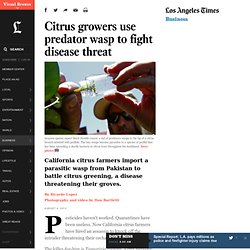
Invasive species expert Mark Hoddle coaxes a vial of predatory wasps to the tip of a citrus branch infested with psyllids. The tiny wasps become parasites to a species of psyllid that has been spreading a deadly bacteria in citrus trees throughout the Southland. More photos By Ricardo Lopez Photography and video by Don Bartletti August 4, 2013 Pesticides haven't worked. The killer-for-hire is Tamarixia radiata, a tiny parasitic wasp imported from Pakistan. Its mission: Rub out the Asian citrus psyllid, which has helped spread a disease that turns citrus fruit lumpy and bitter before destroying the trees. Merial Schmallenberg vaccine approved in France - 19/08. A new vaccine to protect livestock against the deadly Schmallenberg virus has been approved in France, raising hopes it will soon be available in the UK.
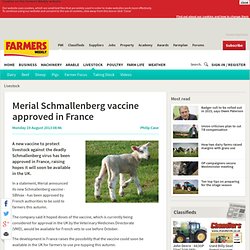
In a statement, Merial announced its new Schmallenberg vaccine - SBVvax - has been approved by French authorities to be sold to farmers this autumn. The company said it hoped doses of the vaccine, which is currently being considered for approval in the UK by the Veterinary Medicines Directorate (VMD), would be available for French vets to use before October. The development in France raises the possibility that the vaccine could soon be available in the UK for farmers to use pre-tupping this autumn. In its statement, Merial released more details about how the vaccine will likely be administered, including how it has performed in trials. "SBVvax is indicated for active immunisation to prevent viremia due to the Schmallenberg virus in sheep and cattle," said the company.
The virus is spreading rapidly and extensively throughout Europe. Would you drink GM wine? French farmer developed industrial snail-slime harvesting process to feed cosmetic industry’s appetite for goo. By ReutersFriday, July 19, 2013 20:16 EDT CHAMPAGNOLLES, France (Reuters) – The French have long appreciated snails on a plate with butter and garlic.
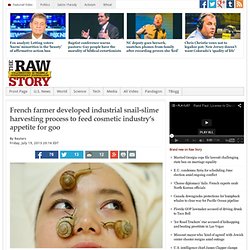
But one rural snail farmer believes the humble molluscs have more to offer alive than dead. Louis-Marie Guedon says the mucus secreted by snails are full of collagen, glycolic acid, antibiotics and other compounds that regenerate skin cells and heal cuts. Guedon, from Champagnolles in the west-central region of Charente-Maritime, believes it could presage a cosmetic revolution and has developed a secret technique to harvest the slime.
He is busy turning the innovation into France’s first industrial-scale snail mucus extraction operation with a target to harvest 15 tonnes of it next year. “I’ve already been producing the slime for three years, but manually,” said Guedon, 47, who has raised snails for a quarter of a century. Bees Under Threat from Disease-carrying Bumblebee Imports - Crop Articles from The Crop Site - The Crop Site. Featured Articles Bees Under Threat from Disease-carrying Bumblebee Imports 20 July 2013.
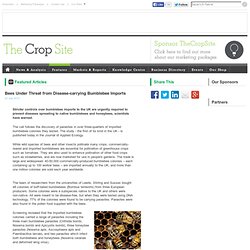
Why Crop Rotation Works - Crop Articles from The Crop Site - The Crop Site. Featured Articles Why Crop Rotation Works 04 August 2013 New research led by scientists at the BBSRC-funded John Innes Centre could help explain the dramatic effect on soil health and yield of crop rotation.
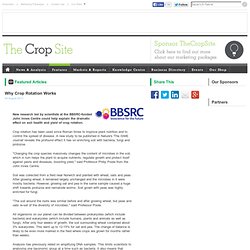
Bee faithful? Plant-pollinator Relationships Compromised when Bees Decline - Crop Articles from The Crop Site - The Crop Site. Featured Articles Bee Faithful?
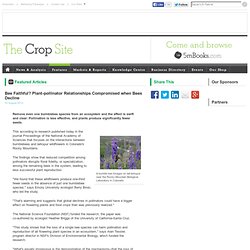
Plant-pollinator Relationships Compromised when Bees Decline 03 August 2013 Remove even one bumblebee species from an ecosystem and the effect is swift and clear: Pollination is less effective, and plants produce significantly fewer seeds. A bumble bee forages on tall larkspur near the Rocky Mountain Biological Laboratory in Colorado.
Revolutionary Technology Allows Crops to Harvest Nitrogen From the Air Instead of Fertilizers. Photo via Shutterstock Have you ever thought of air as the ultimate crop fertilizer?

We haven’t either, but researchers at the University of Nottingham have developed a technology—termed nitrogen fixation—that allows plant to take nitrogen directly from the air. A special bacteria takes up nitrogen from the air and applies it to plant seeds as coating, enabling each plant cell to spontaneously ‘fix’ nitrogen. The new technology could be commercially available within the next couple of years and it has the potential to replace environmentally damaging fertilizers.
The nitrogen fixation process allows plants to convert nitrogen into ammonia. Professor Cocking says the process is not genetic modification nor bio-engineering. The N-Fix technology has of great importance for agriculture, claims Dr Susan Huxtable, Director of Intellectual Property Commercialization at The University of Nottingham. . + Azotic Technologies Ltd + The University of Nottingham Via Phys.org.
Computer model gives early warning of crop failure. An international team of researchers has developed a computer model to predict global crop failures several months before harvest.
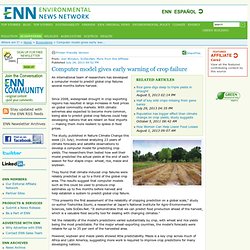
Since 2008, widespread drought in crop-exporting regions has resulted in large increases in food prices on global commodity markets. With climatic extremes also expected to become more common, being able to predict global crop failures could help developing nations that are reliant on food imports — making them more resilient to spikes in food prices. The study, published in Nature Climate Change this week (21 July), involved analyzing 23 years of climate forecasts and satellite observations to develop a computer model for predicting crop yields. The researchers then tested how well their model predicted the actual yields at the end of each season for four staple crops: wheat, rice, maize and soybean. The real threat to our future is peak water.
Peak oil has generated headlines in recent years, but the real threat to our future is peak water. There are substitutes for oil, but not for water. We can produce food without oil, but not without water. We drink on average four litres of water per day, in one form or another, but the food we eat each day requires 2,000 litres of water to produce, or 500 times as much. Getting enough water to drink is relatively easy, but finding enough to produce the ever-growing quantities of grain the world consumes is another matter.
Grain consumed directly supplies nearly half of our calories. Seaweed biofuel: How to farm marine plants. Glyphosate Found in Human Urine Across Europe. People in 18 countries across Europe have been found to have traces of the weed killer glyphosate in their urine, show the results of tests commissioned by Friends of the Earth Europe and released today. Source: foeeurope.org The findings raise concerns about increasing levels of exposure to glyphosate-based weed killers, commonly used by farmers, public authorities and gardeners across Europe. The use of glyphosate is predicted to rise further if more genetically modified (GM) crops are grown in Europe [2]. Find Full Results Here. How do you feed nine billion people?
An international team of scientists has developed crop models to better forecast food production to feed a growing population -- projected to reach 9 billion by mid-century -- in the face of climate change. In a paper appearing in Nature Climate Change, members of the Agricultural Model Intercomparison and Improvement Project unveiled an all-encompassing modeling system that integrates multiple crop simulations with improved climate change models. AgMIP's effort has produced new knowledge that better predicts global wheat yields while reducing political and socio-economic influences that can skew data and planning efforts, said Bruno Basso, Michigan State University ecosystem scientist and AgMIP member.